To power up your Samsung Galaxy Watch, press and hold the side button until you see the Samsung logo appear. If it’s unresponsive, place it on the wireless charging dock until it reaches at least 10% battery. For frozen devices, hold both the power and back buttons simultaneously to force restart. Verify proper alignment on the charging dock—look for charging animations or vibrations to confirm connection. The following tips will help you optimize battery life and address common charging issues.
Standard Power-On Methods for Galaxy Watch Series
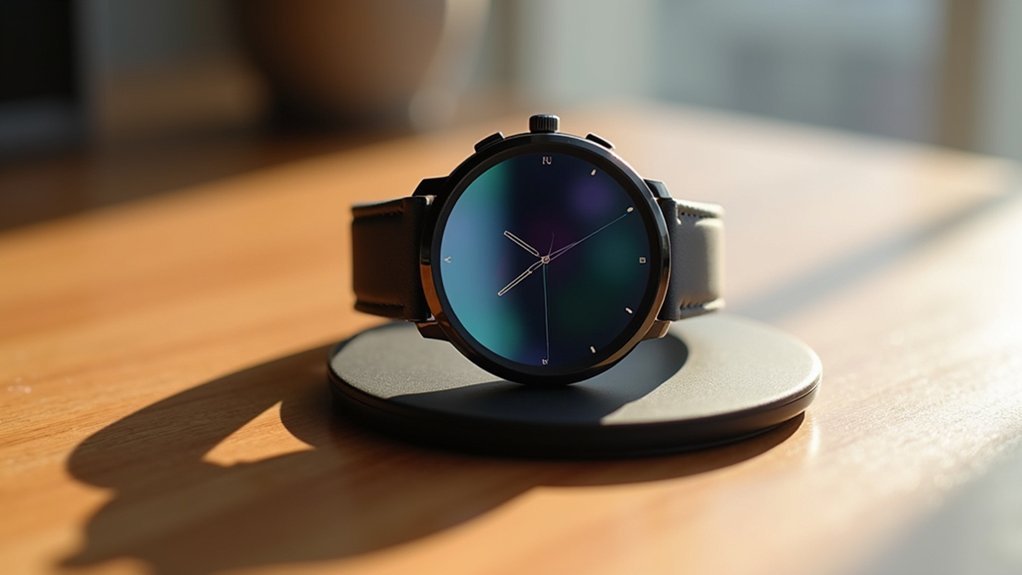
Two simple methods exist for powering on your Samsung Galaxy Watch. The most direct approach is pressing and holding the power button, which is located on the side of your device as the top key.
After a few seconds, you’ll see the Samsung logo appear as your watch boots up.
If your watch doesn’t respond, it likely needs charging. Connect it to the wireless charger dock which is necessary for charging your Galaxy Watch Active. Wait until it reaches at least 10% battery before trying again.
For a frozen watch, you can force restart by simultaneously holding both the power and back buttons until the Samsung logo appears.
Remember that briefly pressing the power button when your watch is already on will simply return you to the home screen—a handy navigation shortcut during regular use.
Battery-Saving Mode Activation Techniques
Maximizing your Galaxy Watch’s battery life is essential for all-day usage, and Samsung’s power saving mode offers a convenient solution. You can activate it through two simple methods.
First, access it via Settings by proceeding to Apps > Settings > Battery > Power saving. To turn it off, tap “OFF” followed by the tick icon.
For quicker access, swipe down to open the quick settings panel and tap the battery or power saving icon, which changes color when activated. Using this quick method allows for immediate battery conservation whenever needed.
When enabled, power saving mode converts your display to grayscale, disables networks, limits CPU performance, turns off Always On Display, and reduces brightness.
It also decreases screen timeout to 15 seconds and disables wake-up gestures.
Consider activating this mode when you expect extended periods without charging.
Troubleshooting Common Charging Issues
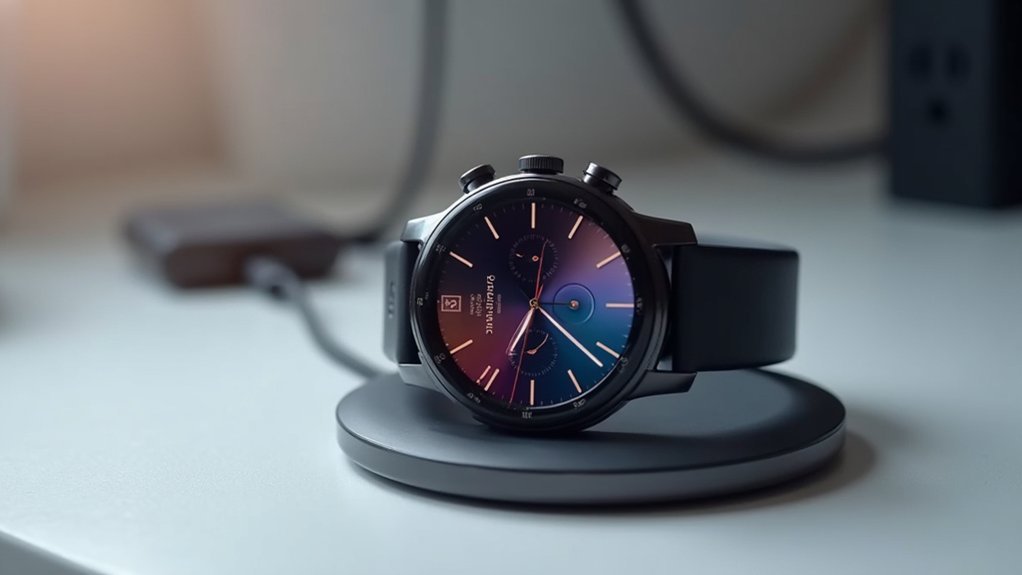
When your Samsung Galaxy Watch won’t charge, check the connection points for dust or debris that might interfere with power transfer.
You’ll need to position your watch precisely on the charging dock, ensuring the magnetic connectors align properly for ideal charging.
If your watch has completely discharged, you may need to wait several minutes after connecting to a charger before it shows any signs of powering on again.
If problems persist, try a different charging cable or power source to determine whether the issue lies with your original charger or the watch itself.
Connection Problems Solved
Despite their advanced technology, Samsung Galaxy Watches can occasionally face charging issues that prevent them from powering up properly.
When your watch won’t charge, first check for any dust or debris on the charging contacts, as even tiny particles can interrupt the connection.
Ensure your charging cable is securely plugged into both the power adapter and outlet. Try a different wall socket or power adapter to rule out power source problems.
Inspect the charging puck and cable for visible damage like fraying or cracks.
For persistent issues, check if the watch needs a soft reset by holding the power button until “Rebooting…” appears. If your phone supports it, you can utilize reverse charging as an alternative method to power up your Galaxy Watch.
Clean charging contacts with a microfiber cloth and avoid placing metal objects nearby during charging, as these can interfere with the wireless charging signal.
Dock Positioning Mastery
Proper dock positioning represents the cornerstone of successful Galaxy Watch charging. When you place your watch on the charging dock, verify the center of your watch’s back aligns precisely with the dock’s center. A charging animation, vibration, or LED indicator confirms proper connection. Always ensure your Galaxy Watch is completely dry before charging to prevent potential damage or malfunction.
| Issue | Symptom | Solution |
|---|---|---|
| Misalignment | No charging/slow charging | Reposition watch on dock |
| Depleted Battery | Won’t power on immediately | Allow several minutes before turning on |
| Connection Glitch | Intermittent charging | Restart watch or charger |
| Physical Barrier | Reduced efficiency | Remove thick case or debris |
If your watch fails to charge, check alignment first. Use a flat, stable surface for your dock and keep magnetic or metal items away. For persistent issues, consider a factory reset or professional diagnosis to rule out hardware faults.
Wireless Charging Dock Setup Guide
Setting up your Samsung Galaxy Watch’s wireless charging dock requires proper alignment between the watch’s back center and the dock’s center for peak power transfer.
You’ll know charging has begun when the dock’s LED flashes red, turning green once the battery reaches full capacity.
For best results, place your charging dock on a flat, stable surface away from water and make certain both the watch and dock are free from debris before charging. Ensure you’re using a Samsung-approved wireless charger to avoid potential damage to your Galaxy Watch.
Dock Placement Essentials
When setting up your Galaxy Watch for charging, correct placement on the wireless dock is essential for efficient power transfer. Always align the center of your watch with the dock and place it on a flat, stable surface to maintain proper contact throughout the charging cycle.
Follow these key steps for ideal charging:
- Center your watch with its back directly on the charger’s surface
- Verify the dock is connected to a Samsung-approved power source
- Check that your watch is stable and not misaligned, as this can prevent charging
If your watch becomes hot during charging, remove it immediately to prevent damage. Pay attention to the LED indicator colors on the wireless charger dock as they reveal important information about the charging status.
For Samsung Galaxy Watch owners who travel frequently, consider alternatives like Wireless PowerShare from compatible Galaxy phones.
Charging Status Indicators
Four distinct LED indicators on your Samsung Galaxy Watch charging dock communicate the exact status of your charging process. Understand these signals to guarantee your watch powers up correctly every time:
| LED Color | Status | Action Needed |
|---|---|---|
| Green/Orange | Standby mode | Place watch on dock |
| Solid Red | Actively charging | Let it charge fully |
| Blinking Red | Charging error | Reposition watch |
When charging begins, your watch screen displays a charging animation with a sound alert. The battery icon transforms into a charging symbol. Once fully charged, the dock LED turns green and your watch’s battery icon shows 100%. For ideal charging speed, use a 5V/2A power adapter instead of older 5V/1A models that produce a cyan indicator and slower charging. If your charger isn’t working properly, you may need to replace it or contact Samsung support if your device is still under warranty.
Optimizing Battery Performance on Galaxy Watches
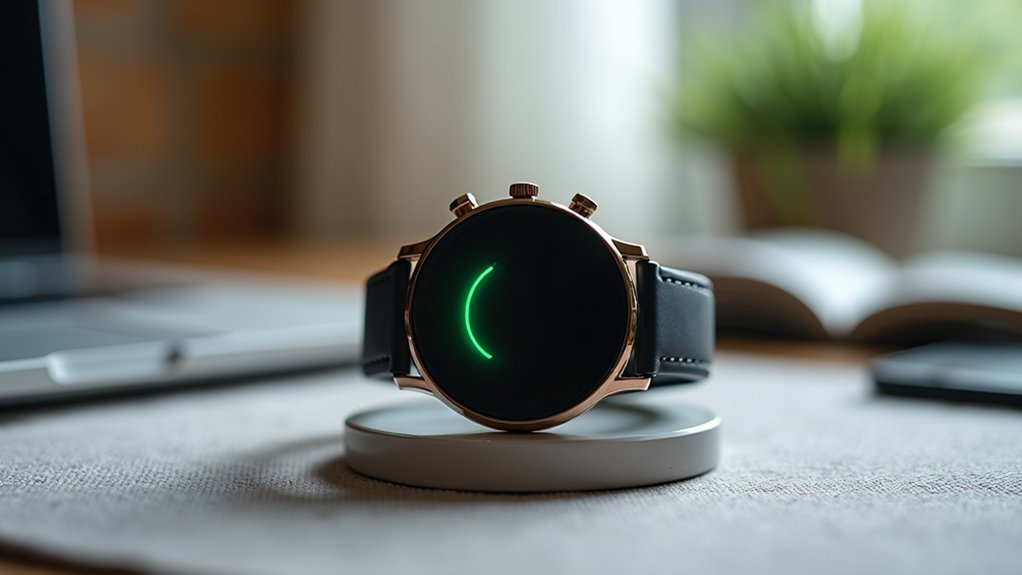
Your Galaxy Watch’s battery life can make or break your experience, so optimizing its performance is essential for all-day use. Start by enabling Power saving mode through the Galaxy Wearable app, lowering your screen brightness, and disabling the Always On Display feature.
Battery optimization is critical for ensuring your Galaxy Watch lasts through your busy day without interruption.
To further extend battery life:
- Manage connectivity wisely by turning off Bluetooth, Wi-Fi, and location services when not needed, and consider using Airplane mode during periods of inactivity.
- Optimize your apps by uninstalling unnecessary ones, limiting health monitoring sensors, and using simple watch faces without animations.
- Adjust display settings by shortening screen timeout, enabling dark mode, and restricting gesture controls like raise-to-wake that frequently activate your screen. Consider using dark-tone wallpapers on your watch interface for better power efficiency.
Keep your watch updated for Samsung’s latest battery optimization improvements.
Quick Restart Methods When Watch Becomes Unresponsive
Despite being reliable devices, Samsung Galaxy Watches can occasionally freeze or become unresponsive, requiring a quick restart to get them working again. When this happens, the most effective solution is the force restart method.
Simply press and hold both the Power/Home button and Back button simultaneously until you see “Rebooting” appear on the screen.
If that doesn’t work, you can access Reboot mode by quickly pressing the Home button, which offers recovery options.
The Galaxy Wearable app on your connected smartphone provides another solution, allowing you to restart or reset your watch remotely.
Different watch models may require slightly different approaches, especially those running Wear OS.
Always confirm before performing a factory reset, as you’ll need to log back into your Samsung account afterward.
For the upcoming Galaxy Watch5 and Watch5 Pro, releasing in April 2025, the restart process will help resolve minor glitches and improve performance immediately.
Power Button Functions Across Different Watch Models

Samsung Galaxy Watch models feature different power button configurations that you’ll need to understand for basic operation.
On the Galaxy Watch Active series, the power button requires a press-and-hold to turn the device on or off, while the Galaxy Watch 7 needs both right-side buttons pressed simultaneously. For powering on specifically, you can hold any button on the right side of the Galaxy Watch 7.
The Galaxy Watch Ultra introduces a customizable Quick button alongside standard power controls, giving you additional shortcuts for activities and emergency features.
Power Button Functions Across Different Watch Models
While all Samsung Galaxy Watches share core functionality, the power button’s specific features vary across different models. Regardless of which Galaxy Watch you own, understanding how to use the power button effectively will enhance your experience.
- Basic Functions: Press and hold the power button to turn your watch on or off. A quick press returns you to the home screen from any app you’re using.
- Button Combinations: On many models, pressing and holding both the power and back buttons simultaneously accesses the power menu, where you can restart your device when needed. Enabling power saving mode can significantly extend your battery life when you need your watch to last longer.
- Model-Specific Features: The Galaxy Watch Ultra includes a customizable Quick button that can be configured for exercise tracking, emergency siren activation, or other frequently used functions through the Settings menu.
Model-Specific Button Layouts
Each Galaxy Watch model features a unique button layout designed for specific user experiences. The Galaxy Watch Active includes just a single Back button that also activates Samsung Pay when held down.
In contrast, the Galaxy Watch Ultra boasts three buttons, including a dedicated Action button that triggers a 105dB siren when held for 5 seconds.
The Galaxy Watch3 and Active2 models strike a middle ground with two buttons (Home and Back) that you can customize via the Galaxy Wearable app.
You’ll find various customization options under Settings > Buttons and gestures, where you can assign functions to short press, double press, or long press actions. For additional personalization, you can also utilize the Watch faces feature to complement your button configuration preferences.
These physical controls work alongside gesture navigation like double-pinch and swipe controls to provide flexible interaction with your watch.
Alternative Charging Solutions When Traveling
Frequent travelers with Galaxy watches understand the frustration of forgetting a charging cable or finding themselves without access to a power outlet.
Fortunately, several alternatives can keep your Galaxy watch powered on the go.
- Wireless PowerShare – Simply place your compatible Galaxy watch (except Watch7 and Ultra models) on the back of your Galaxy phone with PowerShare enabled for convenient charging anywhere. Remember to charge your phone to at least 30% before attempting to use this feature.
- Portable Power Banks – Use a compact power bank with USB output to connect your watch’s charging dock, providing multiple recharges while hiking, camping, or during long flights.
- Multi-Device Charging Solutions – Pack a single multi-device charging pad that can power your watch, phone, and earbuds simultaneously, perfect for hotel rooms where outlet space is limited.
Understanding Battery Health Indicators
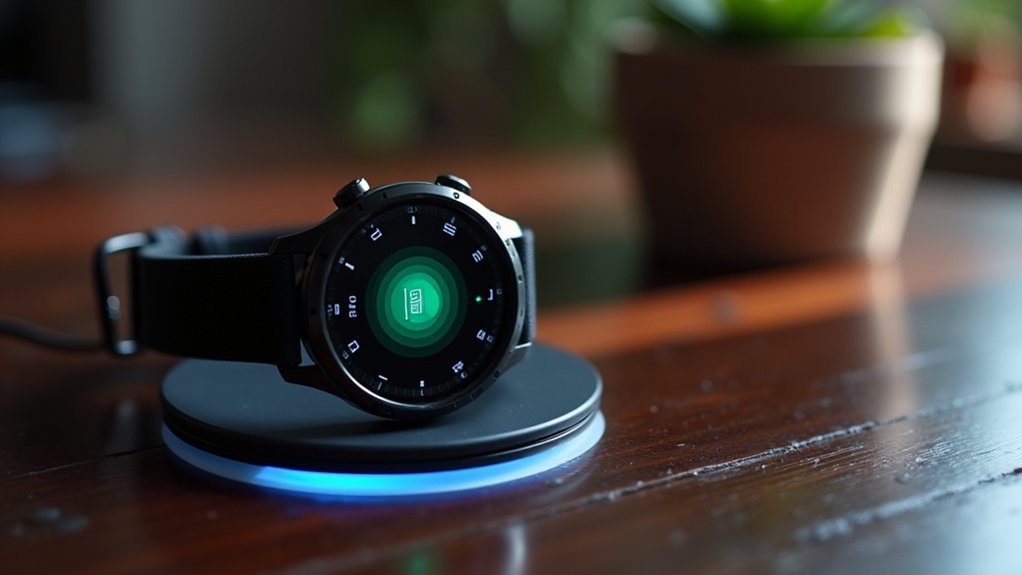
How effectively are you monitoring your Galaxy Watch’s battery health? Samsung provides several ways to check this vital information directly on your device or through companion apps.
On newer Galaxy Watch models (4, 5, and 6), navigate to Settings > About Watch > Battery Information to view your current battery capacity alongside the rated specification.
| Method | Location | Information Displayed |
|---|---|---|
| Watch Settings | Settings > About Watch > Battery | Current vs. Rated mAh |
| Samsung Members | Connected Device Diagnostics | Battery health percentage |
| Galaxy Wearable | Diagnostics section | Health status and alerts |
Understanding these metrics helps you track degradation over time. When current capacity markedly drops below rated capacity, it’s time to reflect on battery replacement. Samsung’s diagnostics can even notify you when your battery needs attention. Batteries degrade naturally over time, which is why regular monitoring is recommended.
Galaxy Watch Emergency Power Options
When faced with critical situations, your Galaxy Watch offers specialized power management features that could prove lifesaving. Your watch automatically conserves battery by limiting non-essential functions during emergencies while maintaining critical services.
To optimize emergency power options:
Configure Emergency SOS, customize contacts, and set fall detection sensitivity to maximize your Galaxy Watch’s life-saving potential.
- Configure Emergency SOS through the Galaxy Wearable app under Watch settings > Safety and emergency > Emergency SOS
- Customize your emergency contacts who’ll receive your location information during activation
- Set up fall detection sensitivity based on your activity levels to prevent unnecessary battery drain
Remember that quickly pressing the Home or Power key triggers Emergency SOS, sending alerts to your designated contacts. For older Galaxy Watch models, you’ll need to enable SOS with Home button in the advanced features section.
Unlike some competitors, Galaxy Watches don’t directly contact emergency services, so proper contact setup is essential for these features to function effectively.
Fast Charging vs. Standard Charging Comparison
Beyond emergency situations, understanding your Galaxy Watch’s charging capabilities can greatly extend its daily usefulness.
While standard charging works with all Samsung Galaxy Watch models using the included wireless dock, fast charging is primarily available on newer models.
Standard charging offers convenience and universal compatibility with various USB adapters and Qi charging pads, but typically delivers slower charging speeds.
Fast charging considerably reduces charge time but requires compatible chargers and higher-wattage power sources.
For daily use, you’ll find the flat charging docks included with newer models like the Watch4-6 series perfectly adequate.
When time is limited, seek out fast charging options.
Some newer models also support Wireless PowerShare, allowing you to charge your watch directly from compatible Samsung phones in a pinch.
The typical battery life for Samsung Galaxy watches ranges from 31 hours to 3 days depending on usage and standby mode.
Extending Battery Life Between Charges
To get the most out of your Galaxy Watch between charges, implementing a few key optimizations can transform your device from a daily-charger to a multi-day companion.
Start by managing display settings, which greatly impact battery consumption.
The display is your battery’s biggest enemy—tame it first for lasting power.
- Disable Always-On Display and lower brightness to minimize screen power usage, then select simpler watch faces that require less processing power.
- Turn off unnecessary connections like Wi-Fi and location services when not in use, and limit background app activities that drain battery silently.
- Utilize power-saving modes during longer periods away from your charger – Watch Only mode offers dramatic battery extension by disabling smart features.
Environmental factors also affect battery performance, so avoid exposing your watch to extreme temperatures during outdoor activities or charging. Setting a shorter screen timeout helps conserve significant battery power throughout the day.
Frequently Asked Questions
Can I Wear My Galaxy Watch While Charging?
While technically possible with small disk chargers and stretchy watch bands, wearing your Galaxy Watch during charging isn’t recommended. It’s impractical, less efficient, and not how Samsung designed the charging experience for ideal results.
Does Water Damage Affect Power Functionality?
Yes, water damage directly affects your watch’s power functionality. It can cause short circuits, corrosion, charging issues, unresponsive displays, and random reboots. Even water-resistant watches can fail after exposure to certain conditions.
Will Factory Reset Erase My Watch Face Collection?
Yes, a factory reset will erase your watch face collection. You’ll need to re-download and reconfigure all your watch faces after the reset as all personal data and settings are removed completely.
Can Galaxy Watch Power on Automatically at Scheduled Times?
No, your Galaxy Watch doesn’t support scheduled power-on times. While you can enable “Auto Power ON” in Battery settings, it can’t be scheduled for specific times. You’ll need to power on manually.
Does Using LTE Significantly Reduce Battery Life Compared to Bluetooth?
Yes, using LTE on your Galaxy Watch greatly reduces battery life compared to Bluetooth-only operation. You’ll notice about half the battery life when using LTE actively, especially in areas with poor signal coverage.
In Summary
You’re now equipped to power up and maintain your Galaxy Watch’s battery life efficiently. Remember to use the proper charging accessories and monitor battery health regularly. If you’re experiencing issues, try the troubleshooting steps before contacting support. With these power management techniques, you’ll enjoy longer battery life and maximize your watch’s performance throughout your day.

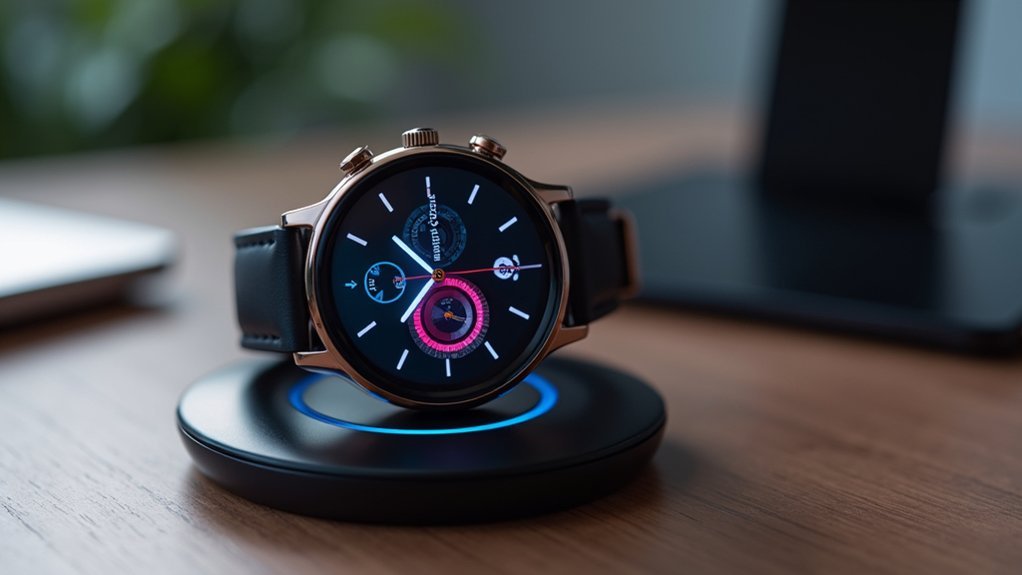

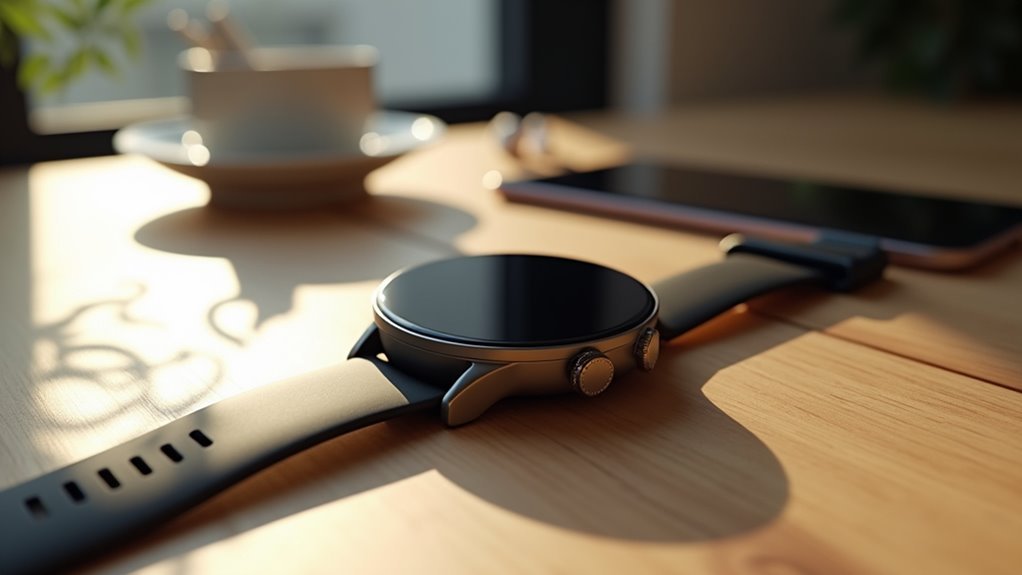
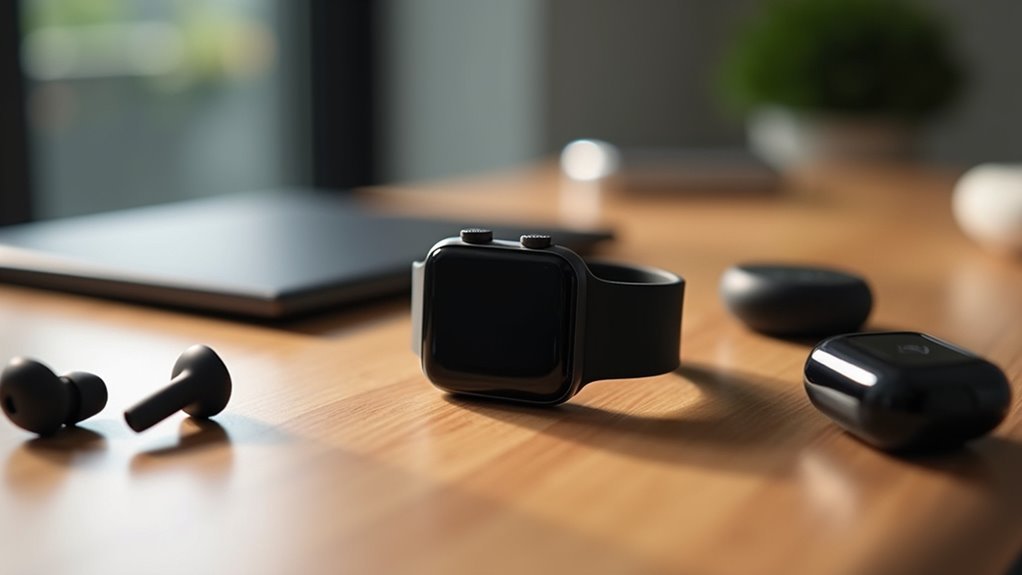
Leave a Reply